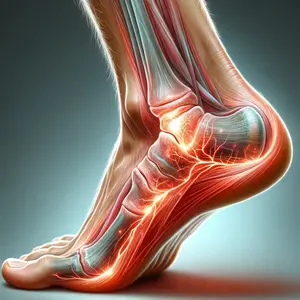Difference Between Plantar Fasciitis and Heel Spurs
Heel pain is, unfortunately, a common complaint among many individuals. The pain can arise from various conditions, but two of the most common causes are plantar fasciitis and heel spurs.
In this article, I will explain to you the difference between plantar fasciitis and heel spurs.
By knowing that, you can have a better understanding of how to approach treatment and prevention of those conditions.
Exercise guide for dealing with the plantar fasciitis, follow the link.
What is Plantar Fasciitis?
Plantar fasciitis is an inflammation of the plantar fascia, a thick band of tissue that runs across the bottom of your foot and connects your heel bone to your toes.
The main function of the plantar fascia is to support the arch of your foot.
This is important because when plantar fascia changes its main function from supporting the foot arch to absorbing the stress when walking, running or jumping, the chances of plantar fasciitis increases.
What are Heel Spurs?
Heel spurs are pointed, bony outgrowths of the heel bone (calcaneus) that occur when calcium deposits build up over several months.
They are often associated with plantar fasciitis, as both conditions can be caused by strain and inflammation of the foot muscles and ligaments.
However, heel spurs themselves are usually painless. If a inflammation occurs on a heel spurs location, then they become painful.
Heel spurs are often detected by X-ray during examinations for plantar fasciitis or other foot issues.
Symptoms:
Plantar Fasciitis:
- Sharp, stabbing pain at the bottom of the foot near the heel.
- Pain is usually worse in the morning or after periods of rest.
- Pain may decrease after a few minutes of walking but can return after long periods of standing or when standing up after sitting.
Heel Spurs:
- May be asymptomatic (not causing any symptoms).
- If symptoms occur, they include a chronic pain in the heel, often described as aching or feeling like a pin or knife is sticking into the heel.
- Pain is not typically influenced by rest or time of day as much as plantar fasciitis pain.
Treatment Options:
Plantar Fasciitis:
- Rest and ice to reduce inflammation.
- Nonsteroidal anti-inflammatory drugs (NSAIDs) to relieve pain and inflammation.
- Physical therapy exercises to stretch the plantar fascia and Achilles tendon.
- Corticosteroid injections for severe cases.
Heel Spurs:
- Treatment may not be necessary if there are no symptoms.
- For symptomatic heel spurs, options include orthotic inserts to redistribute pressure, physical therapy, and over-the-counter pain relievers.
- Surgery to remove the spur is rare but may be considered if pain is severe and other treatments fail.
Footwear and Orthotics:
Plantar Fasciitis:
- Shoes with good arch support and cushioning.
- Orthotic inserts that provide extra support to the arch and cushion the heel.
- Avoid flat shoes and high heels.
Heel Spurs:
- Well-cushioned shoes that absorb impact and relieve pressure on the heel.
- Custom orthotics designed to accommodate the spur and relieve pressure.
- Heel pads or cups to provide extra cushioning and support.
Prevention Strategies:
Plantar Fasciitis:
- Regular stretching of the plantar fascia and Achilles tendon.
- Maintaining a healthy weight to reduce stress on the feet.
- Wearing supportive shoes that fit well.
Heel Spurs:
- Same as plantar fasciitis, with an emphasis on cushioning and support to prevent excess pressure on the heel bone.
- Avoid activities that involve jumping or pounding on hard surfaces.
Exercises Do’s and Don’ts:
Plantar Fasciitis:
- Do perform stretches for the plantar fascia, Achilles tendon, and calf muscles.
- Do strengthen the intrinsic foot muscles.
- Don’t engage in high-impact activities that can exacerbate pain.
Heel Spurs:
- Do focus on low-impact exercises that don’t put pressure on the heel, like swimming or cycling.
- Do use heel pads or cups during exercise if needed.
- Don’t ignore pain during activities; modify your exercise regimen accordingly.
Recovery and Rehabilitation:
Plantar Fasciitis:
- Recovery involves consistent stretching and strengthening exercises.
- Gradual return to full activity levels as symptoms improve.
- Continued use of supportive footwear and orthotics even after symptoms subside to prevent recurrence.
Heel Spurs:
- Recovery may include the use of physical therapy to improve mobility and reduce discomfort.
- If surgery is performed, a period of non-weight bearing and a gradual return to activity is necessary.
- Long-term use of custom orthotics may be recommended to prevent future problems.






